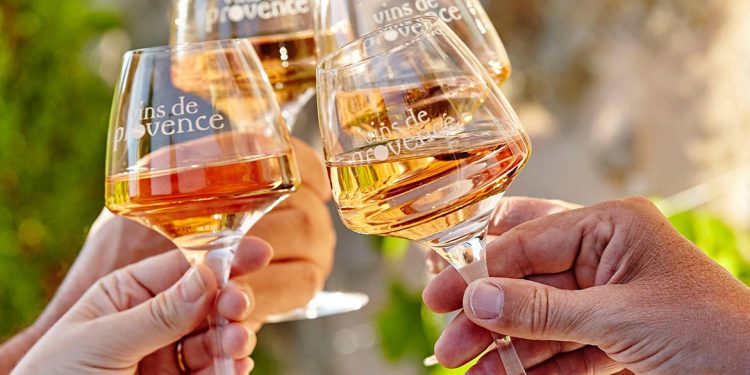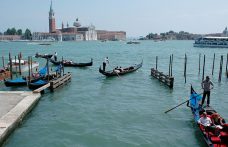
How Rosé Wine is preparing for climate change

The Rosé Symposium focused on how the wine world is preparing for climate change, the challenges facing the industry, adaptation and ecological transition and changing consumer patterns, focussing on rosé.
A short film on Project Bordeaux 2050 for The Association of Journalists for the Environment illustrated the impact of global warming on wines.
Climate change: the long-term impacts on wine
Nathalie Ollat, of INRA (Bordeaux) and co-director of the Laccave research group FV, has studied the long-term impacts of climate change on viticulture and oenology, and on adapting vines resistant to drought and viruses. Rising temperatures shorten the growing cycle, with grapes maturing prematurely, three weeks earlier in northern France, two weeks earlier in the south. Hot summers result in reduced yields, elevated sugar levels, higher potential alcohol, and lower acidity, creating rosés in direct contrast to the current fashion for light, fresh, fruity wines with lower alcohol. Gilles Masson, director of the Rosé Research and Experimentation Centre, observed that acidity levels are dropping globally. Rosé producers have responded by harvesting earlier to retain acidity with lower alcohol, but the resulting rosés have slightly leaner fruit.
Any solution?
Masson spoke of long-term action to counter the hotter summers, including moves to higher altitudes and northerly exposure, although these may place vineyards outside of appellation zones. Viticultural techniques to lengthen maturation times and delay harvest are proving effective. Ollat reported positive results with green pruning and canopy management. In New Zealand, simply green pruning Pinot Noir and Sauvignon Blanc at the right time gave an extra week’s maturation; hard pruning delayed harvest by 25 days. In Australia, experiments with pruning time for Syrah slowed ripening.
New rootstocks and new varieties
Ollat sees opportunities for new rootstocks, as currently five types dominate 75% of the plantings in France. New rootstocks are being researched to determine their interaction with different vine varieties and how they cope with climate change, such as drought and increased soil salinity, caused by increased irrigation. Loïc le Cunff, researcher at the French Wine and Vine Institute, suggested we ask the reverse question: not “Can this variety make a good rosé?” but “What variety could be used for the rosé style we want?”. Experiments with crossing Vermentino and Cinsault have been successful. To help with research, researchers use the Geno-Vigne library of 2,700 historic varieties and INRA’s work on new hybrids, suited to tougher climate conditions and disease resistance. Promising for rosé are Vidoc (late maturation, intense colour, robust with complex fruit and spice aromas) and Artaban (moderate alcohol with good colour). Clonal selection alone appears to have insufficient effect on adapting to climate change.
We should be ready to adapt
There is no single solution. Viticulturalists must be ready to adapt in the field, winemakers in the cellar, and suppliers to consumers in different markets. Mario de la Fuente, Managing Director of PTV (Pataforma Tecnológica del Vino) looked at how are vine growers dealing with climate change in Spain’s four climatic regions: north west maritime; central; southern and Mediterranean. Extreme temperatures and rainfall variation make water management crucial. Research is being carried out with the principal varieties Grenache, Tempranillo, Bobal and Mourvèdre.
How much water?
Wine production, from field to cellar, uses a significant amount of water: on average 250-300 litres per bottle. Optimum usage to avoid waste is vital. Professor Alain Deloire (Montpellier SupAgro) presented his studies on needs of plants under hydric stress, indicating that drip irrigation has little benefit, but a good quantity of water at the right moment in the development of the vines and grapes has significant impact on maturation. He noted that grapes start losing water content after they have reached maturation and that the prescribed dates for irrigation need to be revised.
Technology helps to avoid waste
Sébastien Payen (Fruition Sciences) discussed how technology contributes precision to water management, monitoring evaporation, water in the soil, according to which variety, rootstock and training. Paul Hublart (ITX) demonstrated the software used to carefully monitor how much water and irrigation. In non-irrigated vineyards, yields fall 45% due to smaller grapes. Using the Vintel Interface which uses information on the parcel, rootstock, variety and terroir to give the precise amount of water. Focusing on the vineyards of Provence, Alice Ract Madoux from the Société du Canal de Provence, discussed the advantages of their network of canals, which supplies water for irrigation when, and if, needed.
Some good practices to reduce damage to the environment
Christophe Riou, Deputy Director of the French Wine and Vine Institute, emphasised the benefits to producers of sustainable practices to reduce damage to the environment and increase biodiversity, reduce water consumption and save energy. Use of solar energy and ecological architecture in the cellar are also important. Sustainable in the cellar options include geo-thermal, Canadian wells, solar panels, green roofs, compost. Pierre Naviaux (Comité interprofessionnel du vin de Champagne – CIVC) discussed how the Champagne region was collectively moving towards sustainability. With harvest now happening at the hottest time of year, Masson sees that greater temperature control in the cellar is required. Tiziana Nardi, researcher at the Italian Council for Agricultural Research and Economics is researching how to reduce carbon impact in the cellar. With up to 90% of energy being used for heat removal during fermentation, she has focused her studies on fermenting white wines at lower temperatures, finding that cooling to 19°, rather than 15°, saved 75% energy. Yeast selection is critical to ensure the correct results.
Rosé wine market and forecast trends
Dealing with the impact of climate change on production and wine styles cannot be seen in isolation. During the afternoon the conference looked at the rosé wine market and forecast trends. Dr Richard Delerins, anthropologist in Paris and Los Angeles, has been studying how millennials reshape our modes of consumption. Millennials will comprise three-quarters of the world population by 2028, with significant influence on the economy. Thanks to the internet and social media, it is also the first generation to create a global culture. Chronicling their lives through photos of lifestyle, culture and gastronomy, emphasising enjoying the moment and being ‘Cool’; rosé is the ultimate anti-snob wine. Birte Jantzen, journalist and wine critic for Bettane & Desseauve, noted that the younger generation are also interested in wines which are sympathetic to the environment.
China: a large potential market
Looking at the development of rosé, Brice Eymard, Director of the Provence Wine Council CIVP, noted that currently the largest player in the international rosé trade is from Spain. As sales of dry rosé have been growing, those of sweet rosé been falling: in the US, Germany and the UK. With China a large potential market, Dr Jiaming Wang, of Brock University, has researched attitudes there to rosé. Chinese consumers prefer rosés with red fruit character, confectionary and tropical-fruit flavours, rather than Provence’s citrus or floral flavours. As rosé is usually served chilled, this makes beer – traditional in China – a significant competitor.
The taste of rosé is more important than the colour
Richard C. Delerins observed that ‘Millennial Pink’ is a fashionable colour, supporting sales of rosé wine, but Jantzen was critical on the increasing paleness of rosé, often more like a blanc de noirs. Masson confirmed this trend with a graph showing the decline in colour intensity for rosé wines from Provence, elsewhere in France and worldwide. Elizabeth Gabay MW, author of ‘Rosé, Understanding the pink wine revolution’, made a point that the taste of rosé was more important than the colour. The impact of climate change on rosés styles are emerging, and, as Gabay pointed out there is also development of rosés with greater complexity and diversity with both Jantzen and Gabay enthusiastic about ageing rosés. Following the global trend for local, unusual varieties, Gabay highlighted some which produce distinctive styles: Touriga Nacional/Touriga Franca (Douro, Portugal) and Kékfrankos/Blaufrankish (central Europe), and varieties historically adapted to hot, dry climates: Bobal (Spain), Nerello Mascarese (Sicily), Nergoamaro (Puglia) and Xinomavro (Greece).
The development of different styles
Professor António Jordão (Institute of Viseu in Portugal) challenged winemakers to consider the use of different woods for fermenting and ageing rosé, including cherry, acacia and different oaks and the impact on colour, structure and taste. Nathalie Pouzalgues, oenologist at the Rosé Research and Experimentation Centre showed that in taste tests, Provence rosé was identifiable compared to other similar rosés, and is researching the development of regional styles within Provence, looking at the influence of terroir on Grenache-based rosés. Delegates left with a better understanding of how climate change is forcing viticultural and winemaking practices to adapt, which together with market trends and growing competition, will result in new developments for rosé.
Five examples of rosés from Provence
Clos Cibonne, Côtes de Provence Aoc
100% Tibouren, which needs heat to fully ripen. Fermented and aged in old wooden barrels with some influence from flor and great ageing potential. Fresh red fruit, good acidity with a saline mineral finish and, with age, an appealing complexity of oxidatitive notes
Château Gasqui, Côtes de Provence Aoc
A biodynamic estate with spontaneous fermentation at higher temperatures. Using a traditional blend of numerous varieties, principally Tibouren, Grenache, Syrah, Cinsault and Rolle. Ripe red fruit, juicy, charming and long acidity. Good ageing potential.
Clos St. Vincent, Bellet Aoc
100% Braquet, spontaneous fermentation at warmer temperatutes. Perfumed, peachy, red fruit, with hints of melon aromas. Good weight and intensity of creamy peach and red fruit with mineral acidity and hints of tannin on the finish of the tongue.
Domaine de la Bégude, Bandol Aoc
High percentage of Mourvédre, dark in colour, with good ageing potential. Luscious cherry and black fruit flavours, bone dry, fresh acidity and a touch of silky tannic structure to carry the weight of fruit.
Château Routas, Coteaux Varois-en-Provence Aoc
Cinsault, Grenache based, 300m plus altitude in the north of the area showing cooler climate influences. Freshness, delicacy and a charming floral character give a markedly different character
The 5th International Rosé Symposium (Rencontres Internationales du Rosé), hosted by the Provence Wine Council (CIVP) and the Rosé Research and Experimentation Centre, took place in the auditorium of the Mucem museum in Marseille on Tuesday 22nd January 2019, attended by winemakers, researchers and journalists. The event was sponsored by the CIVP, the Centre du Rosé, the European Union, PACA région sud, Crédit Agricole and Cluster Provence Rosé.
See also ...


The battle continues with the new Chianti Gran Selezione
On 11th November, the Chianti Wine Consortium announced Read more


Changes at the top in Genagricola and Santa Margherita
Big news in Genagricola and Santa Margherita Gruppo Read more


Pinot Grigio delle Venezie: the first national conference
The curtain will rise on the new appellation Read more
